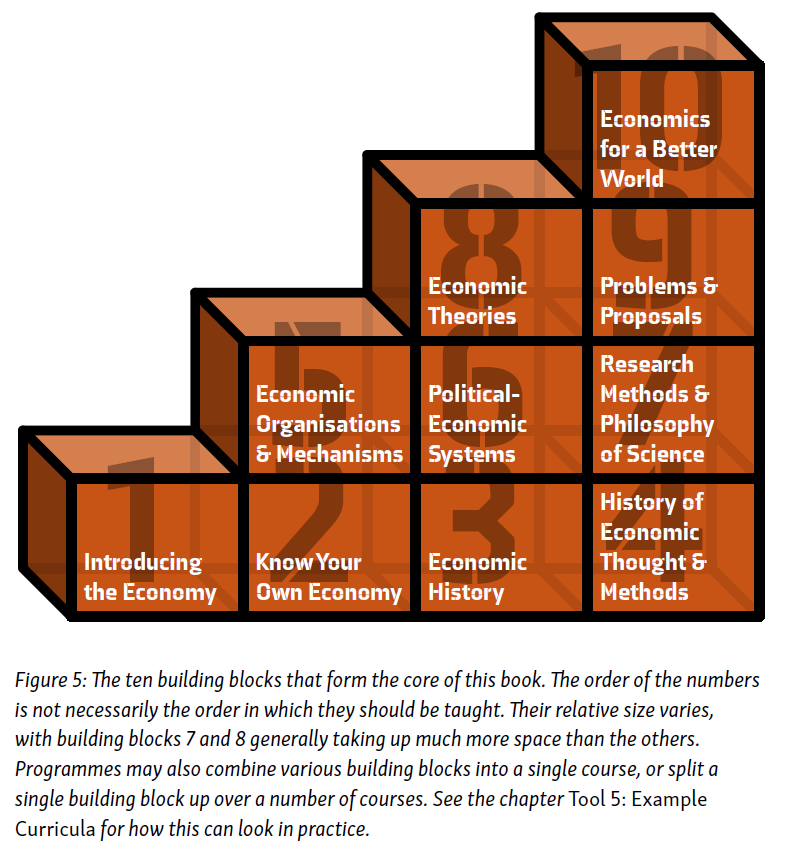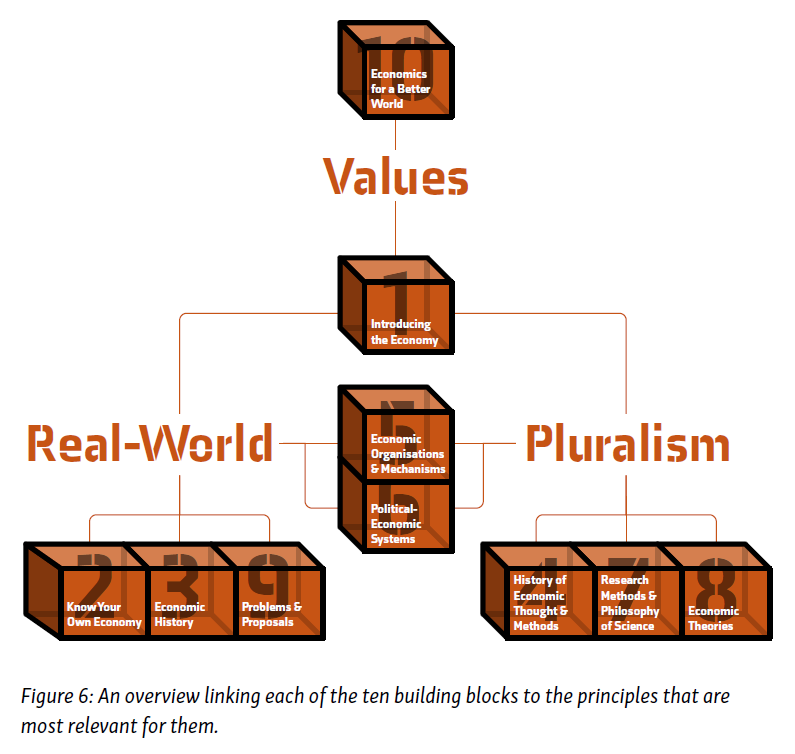The Building Blocks:
This part of the book contains the meat and bones of our curriculum design method: ten thematic areas of knowledge and skills in economics. Each of the ten building blocks covers an area of knowledge or a skill that we see as essential for the education of future economists. These ‘building blocks’ can be used as templates to create courses, of generally six to ten weeks each. One can also pick and choose elements of the different building blocks to combine them into a broader course, or split up a building block into several courses.
This book is designed to help construct a curriculum that fits your specific situation, rather than to advocate one ‘ideal’ curriculum. Hence we have designed the building blocks to be useful for constructing anything from a single course to an entire bachelor programme. They can be shortened, lengthened, combined or altered according to the needs of the programme. We strongly believe that any full economics programme should touch on all ten of these building blocks in some form or other. Shorter programmes, like individual courses or semester-long minor programmes, might do better to pick and choose the most relevant blocks for their particular purpose.

The first two building blocks focus on helping students to develop a feeling for economic matters and teaching them basic conceptual and real-world economic knowledge. Building Block 1: Introducing the Economy discusses the definition and relevance of ‘the economy’ and how it is related to other aspects of the social and physical world. Building Block 2: Know Your Own Economy, explores actual national and local economies and their structures, institutions and sectors.
With this basic knowledge in hand, we explore the history of economic thought and of the real-world economy. Building Block 3: Economic History explores the fascinating and diverse history of economic events and developments. Building Block 4: History of Economic Thought & Methods, in contrast, is about the remarkable and complex history of ideas about the economy. Together, these chapters provide a crucial foundation for students’ further education.
Besides knowing basic economic concepts, facts and history, it is key that economics students learn how economies can and have been organised, at micro-, meso- and macro-levels. Building Block 5: Economic Organisations & Mechanisms investigates the different forms of economic interaction and organisation that operate at each level and together make up an economy. Building Block 6: Political-Economic Systems reviews the complex structures, institutions and power relations that form the overarching structure of an economy.
Another core element of a good economics education is a broad and diverse analytic toolkit, filled with relevant methods and theories. Building Block 7: Research Methods & Philosophy of Science is about both quantitative and qualitative data collection and analysis methods. In Building Block 8: Economic Theories we propose a ‘pragmatic pluralist’ approach to teaching theories by focusing on only the most important insights for every topic. These two building blocks will likely take more space in most programmes than the others, as the centre of gravity of an academic education lies in methods and theories.
The last two building blocks are largely concerned with the productive application of economic ideas in the real world. Economics education should be preparing the economic experts of tomorrow for their future roles in society. Building Block 9: Problems & Proposals deals with the practical skills necessary for the work of almost all economists: analysing real-world problems and working on proposals to address them, whether in a company, government agency, think tank or academic department. Building Block 10: Economics for a Better World deals with the values involved in decision making, asking what normative principles and visions can guide actions to address the major challenges of our times.
Finally, a note on how the building blocks are related to the three principles as illustrated in the figure below. While the principles are present throughout the book, some building blocks are more strongly linked to certain principles than to others. The principle Values shows up most clearly in: Building Block 10: Economics for a Better World. The Real-World principle is most strongly expressed in Building Block 2: Know Your Own Economy and Building Block 3: Economic History, as well as Building Block 9: Problems & Proposals. As for Pluralism, it comes through most distinctly in Building Block 4: History of Economic Thought & Methods, Building Block 7: Research Methods & Philosophy of Science and Building Block 8: Economic Theories. As to combinations of principles, Building Block 5: Economic Organisations & Mechanisms and Building Block 6: Political-Economic Systems combine pluralist analytical tools with real-world knowledge. And finally, Building Block 1: Introducing the Economy combines all three principles.
